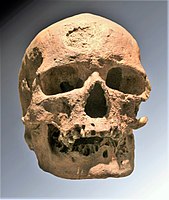克羅馬儂人

克羅馬儂人(Cro-Magnon),或譯克羅馬努人、克洛曼儂人或克魯麥農人等,是歐洲舊石器時代晚期的早期智人群體。[1]
1868年,在法國西南部多爾多涅省萊塞濟德塔亞克-錫勒伊鎮附近Cro-Magnon的一個淺洞穴中,發現一些古老的人類骨骼。法國地質學家 Édouard Lartet 對該洞穴進行調查,發現五個考古層;最上層發現的人類骨骼被證明距當時有10,000至35,000年的歷史。這些骨骼所屬的史前人類被稱為克羅馬努人,與尼安德塔人(學名:Homo neanderthalensis)一起被認為是史前人類的代表。現代研究顯示克羅馬努人的出現年代甚至更早。[1] 根據遺傳學研究,克羅馬儂人可能源自非洲東部,擴散至南亞、中亞、中東,北非,還有歐洲[2]。
克羅馬努人體格健壯,體力強大;據推測大多個體身高約落在166公分至171公分之間。他們的身體普遍沉重而堅固,且肌肉發達。他們的額頭筆直,眉骨微翹,臉型短而寬。克羅馬努人擁有突出的下頷。他們的大腦容量約1,600立方公分,略大於現代人類的平均容量。[1]
他們製作出各種複雜的工具,例如經修飾過的刀片、刮刀、鑿子狀工具、精細的骨器(參見奧瑞納文化)等。[1]
克羅馬努人的住所最常見於由岩石懸垂形成的洞穴中,儘管也發現原始的小屋,無論是靠岩壁的單坡屋頂,還是完全由石頭建造的小屋。岩棚被全年使用。[1]
克羅馬努人製作人類和動物造型的小型雕刻物和浮雕。人類造型雕塑經常描繪大乳房、寬臀的成年女性。[1] 在拉斯科洞窟、萊塞濟德塔亞克-錫勒伊、阿爾塔米拉洞等處的克羅馬努人洞穴壁畫中,發現大量以動物為主題的繪畫,其中一些極其生動;由其精細程度推測,創作者可能經過許多練習和嘗試。[1]
目前的考古證據等難以據以推斷克羅馬努人持續存在時間的長度,以及他們的完整遭遇。[1]
參見
[編輯]參考文獻
[編輯]- ^ 1.0 1.1 1.2 1.3 1.4 1.5 1.6 1.7 1.8 Cro-Magnon | Description, Tools, & Facts | Britannica. www.britannica.com. [2024-08-03] (英語).
- ^ Single, Rapid Coastal Settlement of Asia Revealed by Analysis of Complete Mitochondrial Genomes. Bradshaw Foundation. [2019-01-13]. (原始內容存檔於2019-07-28).
- ^ Cro-Magnon 1 | The Smithsonian Institution's Human Origins Program. humanorigins.si.edu. 1868-01-01 [2024-08-03] (英語).
| 這是一篇與生物學相關的小作品。您可以透過編輯或修訂擴充其內容。 |


